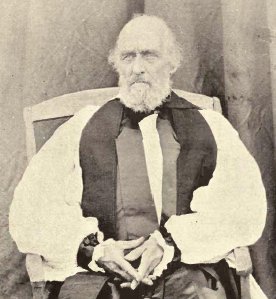William Bompas facts for kids
Quick facts for kids
William Carpenter Bompas
|
|
|---|---|
 |
|
| Born | 20 January 1834 Regent's Park, London, England
|
| Died | 9 June 1906 (aged 72) Carcross, Yukon, Canada
|
| Nationality | British |
| Known for | First Bishop of Athabasca, Mackenzie River and Selkirk |
William Carpenter Bompas (born January 20, 1834 – died June 9, 1906) was an important clergyman and missionary. He worked for the Church of England in northwestern Canada. He became the first Anglican bishop for several areas. These areas included Athabasca, Mackenzie River, and Selkirk (Yukon). These regions were created from the larger Rupert's Land.
William Bompas was born in London, England. He passed away in Carcross, Yukon. His wife, Charlotte Selina (Cox) Bompas, also helped with his missionary work. She wrote a book called Owindia: A True Tale of the Mackenzie River Indians, North-West America.
Contents
William's Early Life
William Carpenter Bompas was born on January 20, 1834. His parents were Charles and Mary Steele. When William was ten, his father died. This left his family in a difficult situation.
William received his early education at home. He had a tutor from Cambridge University. Because he studied at home, William was a shy boy. He preferred to sketch buildings like churches in his free time. His tutor believed William was very smart. He wrote that William learned a lot very quickly.
William decided not to go to university. Instead, he worked at a law firm with his brother. After five years, he moved to another company. This company soon closed, which caused William stress.
A New Path
After recovering, William decided to join the Church of England. He had been part of the Baptist church before. He became a deacon in 1859. He was then appointed to a church in Sutton in the Marsh. This area had not had a resident clergyman for a long time.
There was no school in Sutton in the Marsh. William worked hard to open one within two years. He faced a lot of opposition, but he succeeded.
In 1861, William's mother passed away. He continued his work, moving to different parishes. Soon after, the Church Missionary Society offered him a job. They wanted him to go to Rupert's Land, Canada. William was quickly ordained as a priest and sent to Canada.
Journey to Canada
William's journey to Canada began on June 30, 1865. He left London and traveled to Liverpool. From there, he took a ship to New York. He then traveled by river and railway to Niagara, Chicago, and St. Paul.
When he reached St. Cloud, there was a problem. Local Indigenous people were worried about attacks. William was told they would respect the English flag. He didn't have one, so he made a flag for their ox-carts. This helped, as Indigenous people who saw the flags left them alone.
William finally reached the Red River Colony. From there, Salteaux Indians rowed him in Hudson's Bay Company boats. They reached the Methye Portage on October 12. It was too late to catch a boat further north because winter was coming.
William hired a crew to row him further north. They reached Fort Chipewyan, Alberta after struggling in the cold. He was invited to stay there for the winter. But William wanted to keep going. When the river froze, they continued by land. They reached Fort Resolution in the middle of winter.
After a month, he left Fort Resolution. He had snowshoes and a strong team. William was determined to reach Fort Simpson before Christmas Day. He arrived at the fort on Christmas morning.
Missionary Work in the North
William Bompas stayed at Fort Simpson for a short time. He learned some of the local Indigenous language. Then he went to Fort Norman and started a school. He returned to Fort Simpson in August 1866.
It was decided that William would not have just one church to look after. Instead, he would travel around. This made him very happy. He went back to Fort Norman and began learning the Slavey language. In January 1867, he left for Fort Rae.
After more than a year of traveling, William returned to Fort Simpson. He took charge of the mission post there in August 1868.
Becoming a Bishop
In 1873, William Bompas was chosen to be the first bishop of the new Athabasca diocese. This area was in the northwest of his current diocese. At first, he wasn't happy about leading such a large area. But he was convinced to accept.
In May 1874, Bompas became the bishop of Athabasca in London. He immediately returned to Canada. In 1884, his diocese was divided again. William became the first bishop of Mackenzie River.
In 1891, a new diocese called Selkirk was created in the Yukon. William moved there. In 1905, he retired from his position as bishop. He passed away on June 9, 1906, in Carcross, Yukon.

